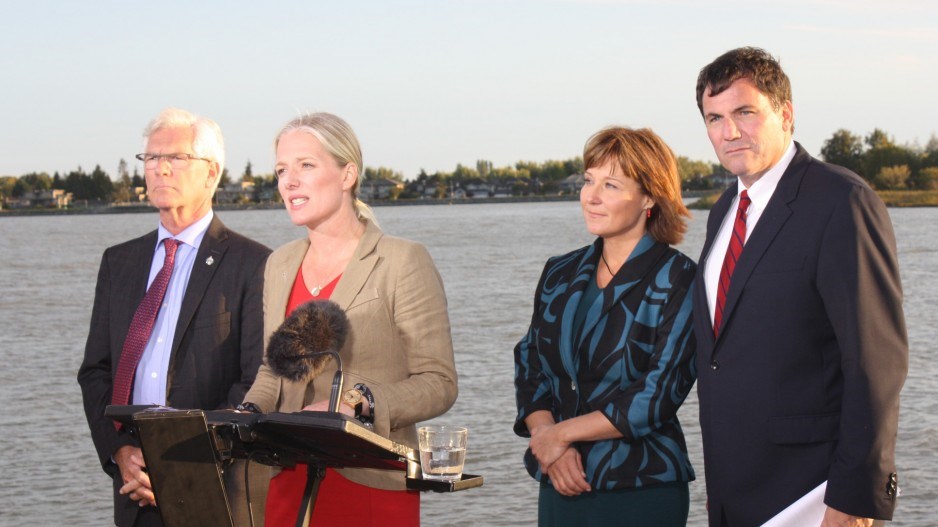Or will the company be able to stay within the cap by using grid electricity instead of natural gas to power some of its ancillary operations? Or will the company be able to simply obviate the cap by buying carbon offsets?
Those were some of the questions that lingered following the September 27 approval of the $11 billion project by the federal government.
In approving the project, federal Environment minister Catherine McKenna announced that, for the first time ever, an environmental certificate will include a hard carbon emissions cap.
As part of the conditional approval, Petronas will need to reduce the projected emissions from the plant by 20%. According to the conditions set out by the Canadian Environmental Assessment Agency, CO2 emissions will be capped at 0.22 tonnes per tonne of LNG for a two-train plant, and 0.21 tonnes per tonne of LNG for a three-train plant.
That means a two-train plant will not be able to produce more than 3.2 million tonnes of CO2 per year, and a three-train plant won’t be able to produce more than 4.3 tonnes per year.
That’s 900,000 tonnes of CO2 less than the plant, as designed, was originally expected to produce annually.
When asked to explain how that will be accomplished, McKenna was unable to explain how Petronas might stay within the new caps.
The Canadian Environmental Assessment Agency has since confirmed that Petronas would not be allowed to avoid the cap by buying carbon offsets.
The New Straits Times quoted Petronas CEO Wan Zulkiflee Wan Ariffin, who said he had not yet seen the details of the certificate.
“The announcement was just made and we need time to look at the conditions and we will review the project,” he was quoted as saying September 29 at an oil and gas conference in Malaysia.
Reuters has reported that anonymous sources familiar with the company said Petronas is now considering selling its majority stake in the project. Petronas owns 62% of the PNW LNG project, with the balance held by four other companies.
David Austin, a lawyer specializing in energy at Clark Wilson LLP, said it’s possible, but unlikely, that Petronas might be able to shave 900,000 million tonnes of CO2 from the project through engineering tweaks.
He thinks the more likely scenario will be one similar to the approach Shell planned to take with its LNG Canada project in Kitimat, which received federal approval last year.
Shell’s project would burn natural gas to drive the refrigeration and compression that chills gas to below 160 degrees Celsius to turn it into a liquid. But for all ancillary uses (lights, instrumentation, pumps and compressors), it would use hydro power.
Originally, Petronas planned to burn natural gas both for the liquefaction process and for ancillary power.
At current prices, it is much cheaper to produce electricity from natural gas than hydro power, although that could eventually change if a new demand for B.C. gas from an LNG industry starts pushing gas prices up. An increase in B.C.'s carbon tax would eventually also increase the cost of using natural gas for power generation.
Austin thinks Petronas may have to change its plans in order to meet the caps being imposed and hook up to the BC Hydro grid.
Although the capital costs of hooking into the grid may not be that significant, the price Petronas would have to pay for hydro power over the plant’s 30-year lifetime could add significant costs to the project.
The price BC Hydro has set for LNG is $83.02 per megawatt hour (MWh). The usual industrial rate paid by other industries is $54.34 per MWh.
“That’s one of the costs Petronas now has to look at in terms of making its final investment decision,” Austin said.
Since the plant’s ancillary power use would be around 150 megawatt hours per year, that would be a sizeable new customer for BC Hydro at a time when it has been losing some large industrial customers and facing a potential power surplus once the $9 billion Site C dam is built.
An even bigger boon, however, would be electrifying the natural gas fields. At Tuesday’s press conference, McKenna spoke of B.C.’s plans to electrify Northeastern B.C.’s natural gas fields as though it were some sort of fait accompli.
But if there is a plan and budget, Austin suggested it's a plan that's short on details.“Nobody’s even said what the plan is,” Austin said.




